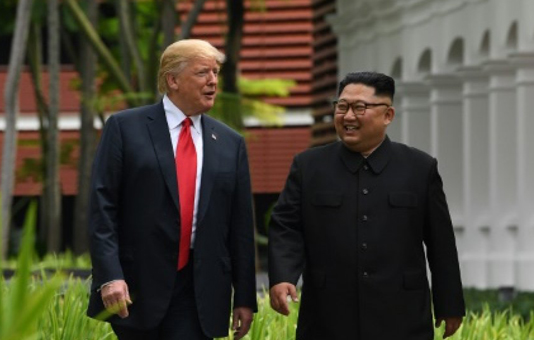WASHINGTON, Jan 27, 2019 (BSS/AFP) – As Donald Trump seeks progress with
North Korea at a second summit, the United States has a series of cards it
can play including easing sanctions, signing a peace declaration or even
pulling troops from South Korea.
After the historic handshake between the US president and North Korean
leader Kim Jong Un in Singapore in June, Washington policymakers are adamant
on the need for tangible concessions by Pyongyang on its nuclear program at
the sequel meeting, which Trump says will take place around late February,
with Vietnam the most likely venue.
But much depends on the mercurial Trump, who has declared his outreach to
the longtime US adversary to be a diplomatic coup and angrily denounced
criticism that his first summit was mere symbolism.
North Korea watchers believe that Kim’s primary goal is relief from
international sanctions and doubt he will suddenly give up his nuclear
arsenal, which his dynastic regime has built for decades even through famine.
The sanctions “are not strong enough to create serious economic problems
in the country, but they are strong enough to make economic growth difficult
or unachievable,” said Andrei Lankov, a professor at Kookmin University in
Seoul who studied in Pyongyang.
“In order to maintain stability in the country and to stay in power, the
North Koreans know they will have to end or at least narrow the yawning gap
between their economy and the economies of the neighboring countries,
especially South Korea and China,” he said.
– Complicated options on sanctions –
When Kim met Trump, the first-ever summit between the two nations, North
Korea was seen as seeking a treaty or at least statement formally ending the
1950-53 Korean War, which ended in an armistice.
But Victor Cha, the director of Asian studies at Georgetown University and
former US negotiator with North Korea, said a peace declaration was
ultimately symbolic.
“I don’t think they would say no to it. A peace declaration would be a
sign of non-hostile intent. But they want tangible evidence of non-hostile
intent, which would be removing some of the sanctions,” Cha said.
Secretary of State Mike Pompeo has vowed no let-up in sanctions until North
Korea denuclearizes. And many US sanctions involve human rights or corruption
laws and cannot be lifted without intervention by Congress, which is unlikely
to be sympathetic.
But Cha said the United States could offer relief indirectly through South
Korea’s dovish government, working at the United Nations to remove sanctions
that impede the restart of inter-Korean projects such as the Kaesong
industrial complex.
The US is already preparing to ease restrictions on humanitarian aid and
could offer to exchange liaison offices with Pyongyang, a step before
diplomatic relations.
Trump points to North Korea’s halt of missile and nuclear tests as
progress, two years after fears soared of war. US officials want a full
accounting of all North Korean weapons sites as well as inspections.
But experts fear North Korea will agree only on dismantling outdated
facilities while keeping its capacities. In 2008, North Korea invited
international media to watch as it blew up a cooling tower at Yongbyon, which
remains the regime’s main nuclear site.
– Focus on long-range missiles? –
South Korea and Japan have increasingly wondered if Trump — who has made
“America First” his guiding worldview — would focus on ridding North Korea
of its fast-moving program of intercontinental ballistic missiles, which
threaten the mainland United States.
Pompeo in recent interviews has described North Korea diplomacy as a way
to protect Americans.
“Fairly or unfairly, that’s being interpreted by our allies as a potential
US willingness to cut a deal that only protects America and disregards the
safety of our allies,” said Bruce Klingner, a senior research fellow at the
Heritage Foundation, a conservative Washington think tank.
The summit also comes amid a prolonged impasse in negotiations on how much
South Korea should pay the United States to maintain its 28,500 troops in the
country.
“There are concerns that Trump may be so eager for a success that he may
agree to signing a peace declaration, signing an ICBM-only agreement and even
reducing US forces on the peninsula either in return for perhaps a freeze on
Yongbyon production or in response to the ongoing stalemate in Seoul,”
Klingner said.
Trump is a longstanding skeptic on the cost value of alliances and is
demanding more from South Korea.
But any promise by Trump to Kim to pull out troops would likely meet wide
opposition in Congress, fury from Japan’s conservative government and quiet
unease from South Korea, where President Moo Jae-in is more supportive of the
US presence than previous left-wing leaders.
And it is not even a given that North Korea would welcome a withdrawal.
Lankov said that Pyongyang saw US forces on the peninsula as a counterweight
to China — its closest ally, but which Pyongyang views as a longer-term
concern.



